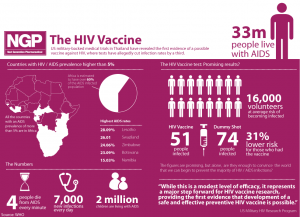HIV ( human immunodeficiency virus) is devastating: it has been estimated that over 63,000 people are living with HIV in Canada, that is to say, about 2 in 10,000 Canadians are carriers of HIV. Thanks to the life-saving medications and treatments like antiretroviral therapy (ART), the life expectancy of HIV carriers has been prolonged dramatically. However, these medications/treatments are not preventive, a large number of people are still getting infected every day: about 5,000 people get infected every day globally.

HIV Infection Statistics Source:https://www.flickr.com/photos/gdsdigital/4016463258
Historically, vaccines have been the most effective and cost-efficient weapon to prevent and eradicate infectious diseases like smallpox and measles. People have assumed that vaccination will be the ultimate solution for HIV/AIDS. However, people haven’t won the battle this time. Scientists still haven’t found a single HIV vaccine that is effective, despite numerous time-consuming and expensive trials and experiments being conducted. The good news is, it is possible to speed up this painful process thanks to the work by Lang Wu and Tingting Yu.
Joint Model for HIV Vaccine Efficacy URL:https://www.youtube.com/watch?v=rZ4hQeLQMfk
Last year, Professor Wu and his PhD student Tingting Yu at UBC (University of British Columbia) proposed an improved model to test the efficacy of vaccines based on the actual data from a clinical trial. Their work makes it possible to predict the likelihood of a certain individual being infected shortly after he/she gets the vaccination. With this in mind, researchers wouldn’t need to wait for years to tell the efficacy of a vaccine, instead, they could spend more time on developing and modifying new vaccines. Hopefully, this will speed up the development of HIV vaccine.
On top of that, this model is not restricted to the assessment of the efficacy of HIV vaccines, according to Professor Wu, it can even be applied to predict the efficacy of treatments to other diseases, including cancer.
Written By Zoe Zhou, Xin Dong, Helen Hu, and Cameron Carvalho
















